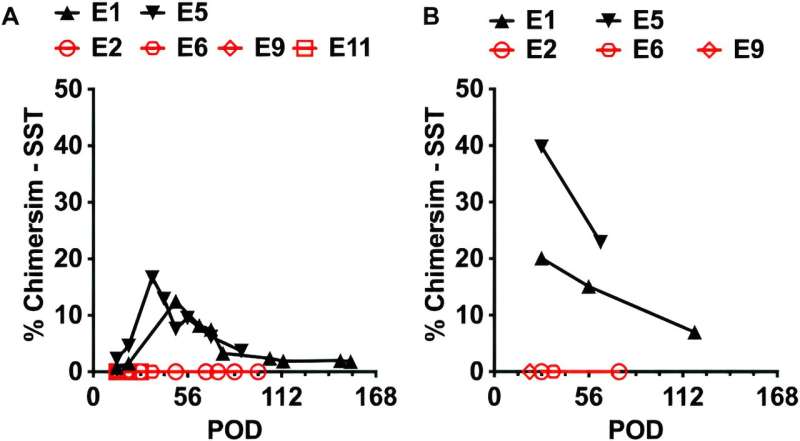This article has been reviewed according to Science X's editorial process and policies. Editors have highlighted the following attributes while ensuring the content's credibility:
fact-checked
trusted source
proofread
Study shows mixing donor and recipient immune systems creates tolerance of transplanted kidneys

Successful kidney transplants rely on the biological compatibility of the donor and recipient but still require long-term use of drugs to tamp down the recipient's immune system and prevent donor organ rejection. Finding a method to increase compatibility can help recipients tolerate a life-saving organ transplant without the lifelong need for anti-rejection medications.
A relatively recent approach that improves donor and recipient biocompatibility induces tolerance by combining irradiation of part of the kidney recipient's immune system and an infusion of donor immune cells. This creates a dual immune system in the recipient. However, this approach has only been successful when important features of the donor's and recipient's immune systems are identical matches.
Transplant specialists at the University of Wisconsin–Madison and Stanford University have developed the new approach, described in a non-human primate model, that may help kidney transplant prospects even when they are less closely matched to donors and in the absence of immunosuppressant drugs.
The research team, led by Dixon Kaufman, a UW–Madison professor of surgery and director of the UW Health Transplant Center, sought to maintain kidney function without rejection in a monkey model resembling human transplants. They also sought to avoid graft-versus-host-disease, a transplant complication in which immune cells from the donor attack its new host.
The experimental transplant protocol, published recently in the journal Transplant International, included 11 monkeys at the Wisconsin National Primate Research Center that were more loosely matched by tissue type than what has previously been accomplished for human donor-recipient pairs.
Two key strings of tissue typing proteins on the surface of cells, known as major histocompatibility antigens, help the immune system recognize parts of its own body as "self." This protects the body from invaders that have different tissue antigens and are recognized as "non-self," thus setting off an immune response. The monkeys in the tolerance induction study had just one match among the two key protein strings, while human transplant pairings previously successful with tolerance induction required two matches.
One day after these monkeys received transplanted donor kidneys, the researchers used thin beams of radiation, delivered by a technique called TomoTherapy, developed at UW–Madison in the 1990s, to irradiate key parts of the animals' immune systems and temporarily suppress them. Ten days after their transplants, the monkeys received an infusion of blood and immune cells from their kidney donors.
The researchers hoped to induce what is called a mixed chimeric state in the recipients—an immune system that is the combination of two animals: part kidney donor, part kidney recipient. Creating mixed chimerism would increase biocompatibility despite tissue typing incompatibility and keep the recipient from identifying the new organ as an intruder and attacking it.
All animals in the study were then weaned off all immunosuppressant drugs. While the chimeric state came and went in some of the monkeys, two monkeys maintained chimeric immune systems. Those two animals remained healthy with normal kidney function with their transplanted organs for more than four years, never developing either a rejection response or graft-versus-host-disease, and without requiring drugs to keep their own immune systems at bay.
"This is the longest duration of tolerance induction reported in this kind of animal model," Kaufman says. "Although more challenging compared to identically matched pairs, this protocol shows that it is feasible to achieve long-term tolerance between more distantly related pairs with tissue incompatibility."
More research aimed at improving the rate of mixed chimerism is necessary, the researchers say, and more studies of the mechanisms underlying mixed-chimerism-based tolerance are underway to help find better methods for inducing the state.
"Knowledge gained through the rhesus tolerance induction model could have direct relevance to a wide variety of donor transplants, including donations from deceased donors that are even more distantly related," Kaufman said. "This could dramatically expand the implementation of tolerance induction protocols beyond the limited pool of living related pairs."
More information: Dixon B. Kaufman et al, Helical TomoTherapy Total Lymphoid Irradiation and Hematopoietic Cell Transplantation for Kidney Transplant Tolerance in Rhesus Macaques, Transplant International (2023). DOI: 10.3389/ti.2023.11279
















